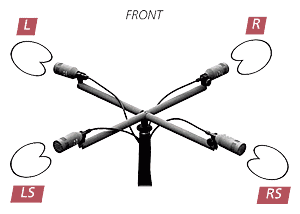The
proposed research project involves finding literature that discusses and
compares 5.1 microphone arrays in order to find a suitable array to apply in
this project. Kamekawa, Marui and Irimajiri created an experiment that compares
eight 5.1 microphone arrays and their application in orchestral recordings. The
subjective listening test compares the arrays on seven different attributes
such a powerfulness, spaciousness and Localisation. This paper is pertinent to
the proposed research because it compares the microphone arrays simultaneously.
“There are a lot of reports introducing
methods and ways to record surround sound. However, it has been very difficult
to compare between multiple microphone techniques under the same condition due
to one or more of the following constraints; namely, the cost of collecting a
large number of microphones in one hall on one day, time and space constraints
of setting up all microphones on a stage, and mixing timbral/spatial
differences created by different microphone techniques.” (Kamekawa,
Marui and Irimajiri 2007)
A
true comparison between recording techniques can only be achieved if the
techniques are recorded simultaneously, this will be the same for the proposed
research; both the 5.1 microphone array and upmixed stereo version will be
produced simultaneously. Kamewaka, Marui and Irimajiri’s listening test also
employs the same kind of method. Inspired by MUSHRA (Multiple Stimuli with
Hidden Reference Anchor), each array was assigned to a slider on a mixing desk,
allowing the test subject too listen and switch between each microphone
technique simultaneously. This meant that there was no specific Anchor or
reference. This method should also be employed in the proposed investigation,
thus eliminating the need to play each technique separately and the possibility
of the listener preference choice being influenced by the order of each
technique being played.
Kamekawa,
Marui and Irimajiri provide an extensive analysis of the results gathered from
the subjective listening test that thirteen students and nine recording experts
participated in. It is the analysis of these results that will form part of the
rationale behind the choosing of a specific microphone array to employ in the
proposed research project. The results showed that across three different
orchestral pieces, the Decca Tree plus Omni-Square array scored the highest on
all seven attributes with the Decca Tree plus Hamasaki-square coming second.
However Kamewaka, Marui and Irimajiri state in their evaluation of the project:
“The result of listening experiment shows
that each microphone array has different character and it is related to the
configuration of each microphone array. Furthermore these characters depend on
impression of the character of music.” (Kamewaka, Marui and Irimajiri 2007)
This shows that there are no “rules”
behind the choosing of an appropriate microphone array because each reacts
differently to the character of music and placement of the array. Not only this
but also constraints such as space and the availability of equipment can
influence the choosing of a suitable microphone array. Thus it is down to the
competence of the sound engineer/researcher to choose the appropriate
microphone technique to test against the upmixing technique in this project.
In light of what
Kamewaka, Marui and Irimajiri’s experiment showed, the proposed researcher has
chosen to employ the IRT Cross (cardioid microphones space 17cm
apart with a 110o angle); this
array was considered third best across all attributes in Kamewaka, Marui and
Irimajiri’s experiment. It has also been said it makes a good compromise
between the factors of stereo image, dynamic range, liveliness and timbre.
(Mason [no date]) (ceoen 1972) The IRT Cross also takes up little space and can
be placed around the venue without any potential to risk health and safety. The
use of far spaced arrays, such as the two techniques that scored highest in
Kamewaka, Marui and Irimajiri’s experiment, would not of been appropriate to
use in this project as it could risk peoples health and safety; microphones
would have to be placed in or above the crowd at the event, which leaves the
potential for injury.
The IRT Cross has a 'brother' array which is very similar called the ORTF array, the difference between the two is one is rectangular and the other is square:
IRT Cross
http://www.schoeps.de/en/home 2013
ORTF
http://www.schoeps.de/en/home 2013
Ceoen Carl. 1972.
Comparative Stereophonic Listening Tests
RadiodifJusion-Television Belge, Brussels, Belgium
Mason Russell. [No date]
Microphone Techniques for Multichannel
Surround Sound
Guildford, UK
Irimajiri Hideo, Kamewaka Toru and Marui Atshusi. 2007.
Audio Engineering Society Convention Paper 7233:
Correspondence Relationship between
Physical Factors and Psychological Impressions of Microphone Arrays for
Orchestral Recording
New York, NY, USA


No comments:
Post a Comment